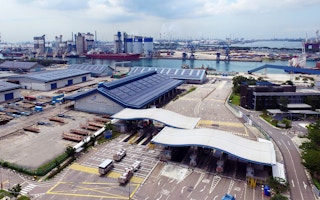Energy-intensive, carbon-heavy industrial ports rarely receive praise for their emissions reduction efforts, but it can be done, and Singapore’s Jurong Port is showing its peers how.
The port of entry for a wide range of non-container goods and cargo ranging from steel, concrete and cement coming into Singapore, energy-hungry Jurong Port moved to build Singapore’s largest single-site solar energy facility in 2016 to power its on-land operations in sustainable, non-polluting ways.
11 football fields in size and boasting a peak capacity of 9.65 megawatts, the port’s solar panel installation provides the bulk of the port’s annual electricity needs. While active, the plant generates even more power than needed, enabling the port to sell the surplus to Singapore’s grid.
Powering the port’s operations with solar ensures the energy consumed can be sustainably provided for, said Tan Wee Meng, chief technical officer at Jurong Port. But the port’s shift towards renewables could also be a model for other heavy industries looking to reduce their carbon footprint while saving electricity costs.
The outcome of a 25-year lease agreement, the facility, other than space, did not cost the port anything while reducing its power bills, with all capital expenditures from installation and maintenance borne by local solar leasing company Sunseap. Sunseap, in return, is entitled to tax breaks and other financial incentives that come with the solar panel system.
With grid energy prices rising and subject to volatility, solar leases offering fixed energy price contracts and often discounts for bigger users are particularly attractive to heavy industries, which usually have unutilised, wide-open areas—such as on Jurong Port’s warehouse roofs.
Tan said the model was advantageous for Jurong Port, with solar energy projected to be eventually cheaper than power from the national grid. Such cost savings will allow the port to better plan long-term finances, he added.
Space an issue
Shifting heavy industries—Singapore’s largest power consumers—is critical if the city-state is to meet its emission targets under the Paris climate deal, said Martin Lim, chief executive officer at Singapore-based electricity marketplace Electrify. 70 per cent of Singapore’s energy goes to industrial and commercial sectors, making it imperative for them to offset consumption and reduce burden on the grid, he explained.
But while the solar leasing model has worked well for Jurong Port, many more factors must be considered before a similar success can be replicated in other areas of Singapore, Lim said.
Space availability is a primary concern. Due to high fixed costs inherent within solar energy agreements, such as contract drafts, consultant surveys, and the installation work of solar panels, solar panel facilities must be of a minimum size. This limits the application of solar panels to wide-open areas, which the city-state’s public apartments, for instance, do not have.
Land tenure is another major factor for consideration. As the sunken costs of solar panel agreements are only recovered after an average of eight to 12 years, solar leasing companies need to close deals on a long-term basis.
For some industrial areas with land tenures of 15 years, the time window for investors to gain their returns is too short. Until these two factors are addressed, significant inertia still resides in Singapore’s solar energy transition, and the application of solar power through leasing models would still be limited largely to expansive industrial areas such as Jurong Port.
For Jurong Port, its commitment to sustainability is not just limited to the solar energy transition, but also in restructuring its storage and despatch chain to cut down on unnecessary cargo movements.
Tan said: “Globally, there is a move towards greener environments. Jurong Port has to make sure that the energy that we consume can be sustainably provided for, that’s why we have chosen solar.”

















